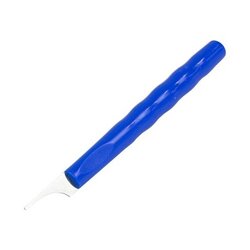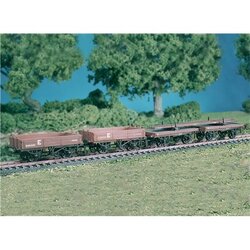Hello
Don't forget to read our latest modelling tips and unboxing videos located at the bottom of the newsletter.
Feel free to send this newsletter to your friends, family and club members if you think they will benefit from it. They can subscribe for free.
Most images in this newsletter are links. Click on them for further details.

For those looking to model the earliest days of the railways, the 'Close Coupled NER P1 Chaldron Wagons' will inevitably be an interesting subject. The Chaldron, known as the wagon that powered the Industrial Revolution, was used to transport coal and first appeared around 1820. This kit by Smallbrook Studios allows a modeller to create three of these interesting wagons. The Hopper is a modern equivalent to the Chaldron and the '13-Ton Hopper' by Parkside is an excellent example of this versatile wagon. For those looking to model the largest of coal-carrying wagons, the 'BR 50 Ton Ballast Hopper Whale' by Cambrian Models would be an interesting choice.



Timber is also a commodity that regularly travels by rail and the 'BR OTA-C Timber Wagon' by Cambrian Models is a good choice for bringing this 46-ton gross laden weight (GLW) Wagon to life. The 'Permanent Way' set of 4 wagons by Ratio is an interesting option for a modeller looking for something different. Specifically configured for track maintenance, the kit consists of two flatbed wagons for carrying rail sections and two low-sided open wagons for the carriage of ballast and track maintenance equipment. Another interesting wagon type is the Gunpowder Van, built mostly during the inter-war period, these wagons were specifically configured for the carriage of explosives and other similarly hazardous substances. The kit by Parkside is a 10-ton version and was in widespread use until around 1960.



The trestle wagon was another wagon configured to carry unusual loads, in this particular case, steel plate. These wagons were a regular sight running between steel mills and shipyards. Parkside represents a 21-ton version used by London North Eastern Railway (LNER). The carriage of livestock inevitably called for a wagon designed specifically for that purpose. The 'Cattle Truck' kit by Dapol is a typical example of this particular type of wagon. Prior to 1968, all freight trains were equipped with a brake van to assist with braking or to help control a runaway in an emergency. One of the most distinctive of brake vans was the 'Dance Hall', operated by Southern Railways and their antecedents. The 'Dance Halls', so named for the amount of open space at each end for the guard, were only finally withdrawn in the 1990s. This kit is from Cambrian Models.



Most kits are supplied empty, luckily, there are a number of options for modellers who wish to portray their trains in a loaded configuration. The 'Mixed Merchandise on Pallets' and the 'Cut Timber Load' are accessories offered by Harburn Hamlet for modellers wishing to provide their wagons with realistic loads. The latter has been specially configured to be used with the previously mentioned 'BR OTA-C Timber Wagon' kit by Cambrian Models. Similarly, Parkside offer a series of 'Wagon Tarpaulins', which are ideal for covering open wagons with weather-sensitive cargoes. The example seen here carries the markings of Southern Railways, although alternative sets are available to cover other members of the 'Big Four' and British Rail.



Wagon kits present a great deal of choice to the modeller and inevitably offer opportunities for personal configuration of wagons. It should be noted that with some wagon kits additional components may be required, such as individual couplings, so it is always good to check the requirements for individual kits before purchase. Wagon kits offer a different challenge to modellers and help them develop and hone skills that are not necessarily exercised in the development of a layout. They also offer an enjoyable build experience and a cost-effective means to develop a large and diverse collection of wagons. They also work well in conjunction with ready-to-run wagons. This is a significant benefit to the modeller who has an interest in a particular type of wagon but doesn't want to expend a great amount of time on a large number of kits. Why not consider adding some wagon kits to your collection?
- Were twin-bolster wagons rigidly joined together?
- How can I prevent the yellowing of my decals?
- What is a 'Trestle Wagon' and what was it used for?
- Can I use a battery to power a small, portable layout and if so what voltage would best suit?
- Can I apply washes and other weathering techniques over decals and stencils without damaging them?
- What is best flexible track or set track?
- What is the difference between modern image and present day?
- How can I use Wire Glue on a layout or diorama?
- What do I need to add smoke to my model locomotive?
- Which N gauge Tracksetta templates create which radius bends?
- Expotools AB500 Portable Spray Booth
- Wills Kits SS27 Station Halt with Building OO/HO Gauge
- Plastic Soldier WW2V20006 German Halftrack Sdkfz 251/D in 1/72 Scale
Do you need to order?
Send us an email or give us a call to check availability or to reserve anything, whatever scale you model in. As usual, if we do not have in stock what you are looking for, we will order it for you and you will get it fast (usually within a week if the manufacturer has it in stock). We place weekly orders with most suppliers.
Remember, you can park for free for one hour on the High Street. So no excuse not to come and visit us!
Upstairs Downstairs is open Tuesday to Saturday 10am till 4.30pm. Obviously, our website is open 24h a day and we can post to most locations, including Europe, USA and Australia.
Upstairs Downstairs
3 Pier Street
Sandown, PO36 8JR
Isle of Wight
Tel: 01983 406 616
http://www.trainshop.co.uk or find us on Facebook
If for some reason you do not want to receive this newsletter anymore, click this link to unsubscribe